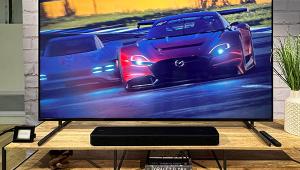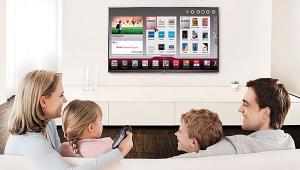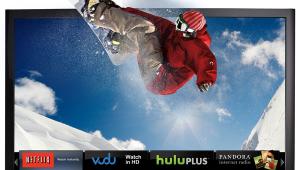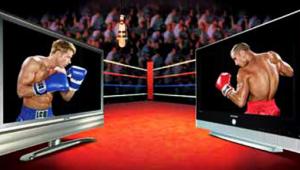It would be really helpful if the links on the "Specs, Myths, and Lies" page were kept up-to-date. All 3 links in the article lead nowhere.
Specs, Myths, and Lies
No matter what type of display you're looking for, you're no doubt going to be comparing the specs and feature lists of each. Things like contrast ratio, lumens, 3:2 pull down, and others are a marketing departments favorite tools to make their product sound better than another. Take many of these with a grain of salt. Take others as an undersold but vital aspect of a product. To sort though them, here's what they all mean.
Contrast ratio
This is the biggie. Almost all current TVs will spout their contrast ratio as a badge of honor, but what is it exactly. It's the ratio of how light it can be v. how dark it can be. So if you measure the brightest a TV can get, and then divide that by the darkest the TV can get, you get it's contrast ratio. This number doesn't necessarily mean that the display has a good black level, it just means there is a certain difference between it's black level and it's total light output. Common numbers are 3000:1, or 5500:1. In reality, these numbers are meaningless, and mostly bunk. Unlike how most things are measured (like gas mileage on a car for instance), there is no specified way to measure contrast ratio. This can lead to wildly different numbers. One company could measure their TV at a color temperature of 9300 Kelvin, which will be a completely different number if the TV were set at the correct color temperature of 6500K. Another case a company could remove elements in the screen, getting a great number, but one that is unlike anything you'd get in your home. In our labs, we often measure contrast ratios that are less than half what the specified numbers are. Sometimes, they're even less than that. If we haven't measured the models you're looking at (sorry!) then trust your eyes over this spec.
Lumens
This is another favorite spec, and it attempts to specify how bright a display is. It shares most of the problems of contrast ratio, namely there is no specified way to measure it. ANSI Lumens, on the other hand, do have a specified way of being measured. It is more likely that you can compare ANSI Lumens and get a general idea of the difference in light output between two products.
SVM
Also called Scan Velocity Modulation or the backwards sounding Velocity Scan Modulation. This is a "feature" included on most CRT based TVs. What this does, is it slows the scan speed of the electron beam on bright portions of the image, and speeds it up on the dark portions. It makes the bright parts of the image brighter, and the dark parts darker. But the side effect is edges become artificially sharp. At first glance the image appears sharper, but you are actually losing all the fine detail that the set is capable of. You're losing resolution.
Anything called "Edge Enhancement"
Trust me, if a TV has this, it's not a feature. Often manufactures will try to cover the overall softness of their display with electronic trickery that "enhances" the detail. Most of these just add noise or other artifacts. If you can turn them off, though, then you're ok.
Anything to do with speakers
No matter how they tweak, augment, or tout the built in speakers of a display, the fact of the matter is, they're not going to sound very good. No built in speaker can match the sound quality of even a low priced bookshelf speaker and sub combo.
Progressive scan with 3:2 Pulldown
This one, despite it's fun name, is actually a good thing. Almost all movies are shot on film, which is 24 frames per second. TVs are either 30 or 60 frames per second. In order to play back film based movies on a TV, you need to duplicate the film frames in a 3,2,3,2,3 (etc.) sequence. On a regular interlaced TV, this doesn't create any problems. But with modern progressive scan TVs, "de-interlacing" or making the image progressive to match the TV, done incorrectly can lead to noticeable artifacts. Almost all TVs have this ability now, though some are better at it than others. For more info on this, check out this article and this article.
Viewing Angle
Just about any display that advertises its viewing angle is trying to hide the fact that it's viewing angle isn't very good. Plasmas and direct view CRTs have the best viewing angle. You can watch them from just about any place in a room. RPTVs (of all types) are next, with an obvious sweet spot, but decent picture quality off axis (not right in front of the TV). The worst is direct view LCDs, most of which have far worst picture quality off axis. Ignore the numbers, check this in the store.
Comb Filter
This one is another with great nomenclature. It's name really doesn't tell you anything about what it does at all. Comb filters are only for the composite input. It is how the TV separates the color information from the black and white info to make the image. Done poorly, this can lead to dot crawl, cross color, and other artifacts. The most common in use now is a 3D Y/C digital comb filter. Most people don't use composite anymore, but if you do, check this in the store as well and see if you see any strange artifacts.
1080p
This is a big one, and it addresses several things. One, it could be talking about the actual resolution of the display. Many LCD, RPTV and a few plasmas are now 1080p resolution. If you sit more than 10-feet away from your TV and are thinking about buying a TV that's smaller that 60-inches diagonal, your eye won't be able to resolve the difference between 1080p and 720p. So in reality you can save your money and get a 720p TV. I'm guessing most of you won't care about that piece of science, so the second aspect of this number is more important. Even if the display is 1080p, doesn't mean it can actually accept a 1080p signal. As I discussed here, this isn't a huge deal. If it will bother you that you can't send your TV it's "native rate" of 1080p, then make sure the TV you're getting is able to accept 1080p.
Burn in, Lamp Life, and Half-life
These are two hotly discussed topics. Plasmas (and CRT based TVs) can have an image “burned in” to their phosphors, creating an ghostly after-image when the screen goes dark. If left unchecked, this can become essentially permanent, marring your screen for years to come. For most decent new plasmas, this isn’t much of an issue anymore. When you get the plasma, turn the contrast down to about 80% (you won’t notice the drop in brightness), and vary what you watch for the first 100 hours (no all-day CNN, video games, or letterboxed movies). If you see the start of burn in, watch something else for a bit, or get a test DVD like Digital Video Essentials that has a test pattern that is a full white screen. This will “burn off” the “burn in”.
LCDs use lamps to create light. They’re just like the fluorescent lamps in your office, only they’re a lot smaller and last a lot longer. These will doubtless last longer than you’ll have the TV.
The lifespan of plasmas is measured in “half-life.” This is the amount of time till the plasma is half as bright as when you bought it. Most new plasmas this is around 60,000 hours. If you turn the contrast down, it will last longer than if the contrast is all the way up (the candle that burns twice as bright lasts half as long…). Keep in mind that the plasma is still watchable after 60,000, it’s just not as bright.
- Log in or register to post comments























































